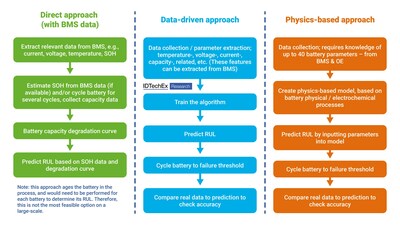Battery Modeling Approaches for Second-Life Applications, Discussed by IDTechEx
PR Newswire
BOSTON, June 7, 2023
BOSTON, June 7, 2023 /PRNewswire/ -- Battery performance testing forms an important part of the second-life EV battery market. Remanufacturers will aim to use the best-performing EV batteries in their final second-life systems, such as stationary storage systems or lower-power electromobility applications. While considerations related to procurement, disassembly, and reassembly procedures must be considered by remanufacturers, understanding the performance of the retired EV batteries is also crucial. This is because this will impact the performance of the final second-life battery once repurposed. In their latest report on the topic, "Second-life Electric Vehicle Batteries 2023-2033", IDTechEx analyses the various methods players are using to model and estimate important retired EV battery performance parameters.
Key battery tests that would typically be performed would be State of Health (SOH), internal impedance, and remaining useful life (RUL) tests. RUL is an estimation of the time left before a battery first falls below a failure threshold. For most first-life EV batteries, this is an end-of-life capacity of 70-80%. Batteries with a high SOH and RUL and low internal impedance would be the most suitable for second-life applications.
Key stakeholders that would perform these tests include second-life battery repurposers and battery diagnosticians developing performance models. Start-ups developing these models could provide battery performance information to repurposers in the current market. In the future, automotive OEMs may use these technologies to comply with regulations such as the Battery Passport in the EU, which will require OEMs to pass battery health information onto a repurposer.
To calculate RUL, a battery would need to be cycled, and its capacity degradation curve extrapolated to the failure threshold. Extended cycling is time-consuming and ages the battery. Moreover, after a certain number of cycles, degradation will no longer be linear, therefore reducing the test's accuracy. Therefore, there is a need for alternative, more accurate and rapid methods to estimate RUL.
These approaches include data-driven techniques, such as machine learning (ML), adaptive filter and stochastic process methods, or physics-based modeling. For example, Californian start-up ReJoule develops battery management and grading technology solutions and have a technology that combines ML with electrochemical impedance spectroscopy and statistical modeling techniques. An Indian start-up, Oorja Energy, combine both physics-based and data-driven techniques. Limited experimentational data is added to their applied physics model, and ML algorithms are used to hone in on an accurate result. The advantage of this is the time saved versus developing a pure physics-based model.
Both data-driven and physics-based methods have their pros and cons and are a balance between modeling speed and accuracy. With ML methods, these can be fast at modeling performance on a large batch of batteries, though they can be prone to overfitting and limited to specific battery architectures. In the future, pure physics-based models may aim to be battery chemistry agnostic. This would provide benefits to multiple stakeholders for the streamlined grading of large volumes of retired EV batteries, irrespective of design. However, physics-based battery modeling is incredibly complex, as all conventional materials and properties need to be known to fully model different aspects of a battery. Many of the materials used in a battery are engineered materials, and thus knowing factors such as anode porosity is difficult without a battery manufacturer providing such specifications to an automotive OEM or a modeler thereafter. Therefore, developing physics-based models can be time-consuming as modelers may need to calculate and understand these specific battery metrics themselves.
It is important for remanufacturers to measure retired EV battery performance and RUL rapidly and accurately. Currently, most diagnosticians are developing data-driven models, sometimes supplemented by other techniques via a hybrid modeling approach. This acts as a short-term solution for repurposers looking to understand the suitability of retired EV batteries for second-life applications. However, data-driven modeling is still typically limited to certain battery architectures, restricting its commercial viability if not compatible with a remanufacturer's retired EV batteries. Clearly, there is a need for greater EV battery standardization and/or the development of battery-agnostic models to help overcome this barrier and facilitate better technology compatibility on a wider scale.
To find out more considerations about the testing and modeling of retired EV battery performance, please refer to IDTechEx's new report "Second-life Electric Vehicle Batteries 2023-2033". The report includes more on the following information: second-life regulatory landscape, battery technology developments, second-life battery techno-economic analysis, key player activity, and 10-year forecasts for the second-life market (GWh installed) and EV battery availability.
About IDTechEx
IDTechEx guides your strategic business decisions through its Research, Subscription and Consultancy products, helping you profit from emerging technologies. For more information, contact research@IDTechEx.com or visit www.IDTechEx.com.
Images download:
https://www.dropbox.com/scl/fo/ihuqpnmkq5neguu5cr16o/h?dl=0&rlkey=mfpjsmz8yvn91li6881bbm4ff
Media Contact:
Lucy Rogers
Sales and Marketing Administrator
press@IDTechEx.com
+44(0)1223 812300
Social Media Links:
Twitter: www.twitter.com/IDTechEx
LinkedIn: www.linkedin.com/company/IDTechEx
Facebook: www.facebook.com/IDTechExResearch
Photo: https://mma.prnewswire.com/media/2095665/IDTechEx_BMS_data.jpg
Logo: https://mma.prnewswire.com/media/478371/4072742/IDTechEx_Logo.jpg
![]() View original content to download multimedia:https://www.prnewswire.com/news-releases/battery-modeling-approaches-for-second-life-applications-discussed-by-idtechex-301845226.html
View original content to download multimedia:https://www.prnewswire.com/news-releases/battery-modeling-approaches-for-second-life-applications-discussed-by-idtechex-301845226.html
SOURCE IDTechEx




